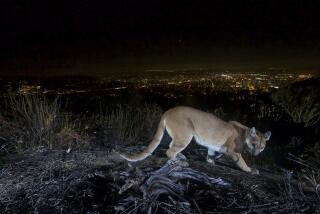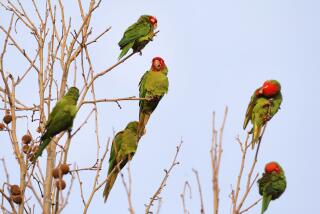Opossums Aren’t Playing Possum : Animals Flourishing in Wooded Areas of L.A. County
One night a couple of years ago, Long Beach real estate investor John Packard was sitting in the Jacuzzi of his condominium when “all of a sudden I saw this thing, one foot in the cat’s water dish, going chomp-chomp-chomp on the cat’s food.”
The “thing” was the size of a cat, with a long ropey tail, ash gray fur and a white, snouty face. It looked sort of like a rat, but bigger. “I didn’t know if it was a pig or what,” Packard recalled.
Actually, both pigs and rats are more closely related to each other (and to human beings, in fact) than to this creature. The animal was an opossum, North America’s only marsupial. Like its more glamorous Australian relatives, kangaroos and koalas, the female opossum has a pouch rather than a placenta. The young are born in an embryonic state and crawl into the pouch to nurse and continue their development.
Shy, Solitary Creatures
Nobody knows exactly why, but the local opossum population seems to have had a recent sharp increase. Because possums are shy, solitary creatures that only come out at night, wildlife officials say it’s hard to estimate their population. But the Los Angeles City Animal Control Department, which regularly flies suburban wild animals by helicopter to remote parts of Angeles National Forest, has trapped 400 opossums so far this year. Last year the number was 100.
Also on the increase is murine typhus, a mild disease that’s spread by fleas who feed on opossums. The same fleas can infest dogs and cats. Eight human cases of murine typhus were reported at the end of last year. This year so far there have been 10.
“If your dog gets hold of a possum, it’s not the end of the world,” said Dr. Joseph A. Marron, the Los Angeles County Animal Control veterinarian. “But people are at risk if they have too many possums around. Keep them at arm’s length. Don’t offer them food. And clean up any woodpiles and old tires in the backyard. Possums love to make homes of them. They also love ivy.”
Marron added: “It’s something not to panic over, but have a little knowledge.” Most cases of murine typhus reported so far have been in the neighboring communities of Hollywood, Silver Lake, Echo Park, Mt. Washington and Eagle Rock. The disease, which has flu-like symptoms, responds well to antibiotics if treated promptly. It cannot be spread from human to human, and there have been no human deaths from murine typhus in California.
Other than that, opossums are not considered problem animals. “They do raid garbage cans,” said Dr. Sarah George, assistant curator of mammals for the Natural History Museum. “But not as bad as raccoons. They’re just not as smart.” And Marron noted that “we have never had a case of rabies in a possum.” They don’t attack people or pets, although when threatened, they often open their jaws very wide to reveal an alarming amount (50, to be exact) of sharp, alligator-like teeth.
A Ferocious Look
“They’ve got this horrible, ferocious look when they open their mouth,” said Los Angeles City Animal Control spokesman Dyer Huston, “but I think to get one to bite you you’d almost have to put your thumb in its mouth and close its jaws.”
Another defense, of course, is playing possum. Nobody knows whether the animal is purposely pretending to be dead, or whether fear causes it to go into a rigid state of paralytic shock. Calculated deceit may be beyond opossums. They’re not considered very bright.
“But that’s a human definition,” said Michael Crotty, curator of mammals at the Los Angeles Zoo. “It does have a relatively small, non-convoluted brain--I read somewhere that a possum’s brain is only 20% the size of a raccoon’s. But they’ve done pretty well with what they have.”
Opossums are ancient animals--between 75 and 100 million years old--that have seen Antarctica go from warm to cold, continents drift apart and dinosaurs disappear. They were around when elephant ancestors looked like tapirs, horses were the size of fox terriers and dogs and cats were primitive, civet-like prototypes called creodonts.
Opossums have survived so well partly because they eat practically anything: grubs, worms, insects, lizards, frogs, plants, young birds, pet food and human garbage. They breed rapidly, and can have as many as 13 young in a litter. Their nocturnal habits allow them to avoid harassment from their chief urban enemies: dogs and people.
‘Basically the Same Model’
While other animals became more specialized, the opossum remained pretty much the same. “That group of marsupials is considered to be the most primitive. The kangaroo family is the most modern,” Crotty said. “The possums you see running around today are basically the same model as the ones millions of years ago.”
Like New World monkeys, opossums have prehensile tails, which can be used to hang from tree branches.
The North American opossum, also called the Virginia possum, ranges as far north as southern Ontario but does not occur naturally west of the Rockies. It was introduced here in 1906 as a game animal by settlers from the Arkansas area, who were accustomed to hunting the creatures for food. As Southern California became more urbanized, opossum hunting died out. Opossums, however, did not.
“It’s one of those animals that’s been able to exploit man,” Crotty said. One reason for the opossum’s recent success may be that the barren Los Angeles housing tracts of 25 years ago have matured into lush, tree-lined habitats. This may be why some people who have never seen opossums are encountering them for the first time, and others are discovering that occasional visitors have become permanent residents.
Joan Givan, an interior decorator who lives in Sherman Oaks, has trapped about 15 opossums in her backyard for the Los Angeles City Animal Control Department to relocate. “For a while I felt sorry for them so I put out plates of cat food,” she says. “That made it worse. They got into the attic, where they eliminate and make noise. And they propagate like rabbits.”
City Animal Control spokesman Huston emphasized that the department only relocates opossums when people complain about them. “We’re not out there making sweeps.”
Even people who find opossums a problem sometimes succumb to their primitive charms. When Givan came across an injured mother opossum, she trapped it and took it to the vet. “All of a sudden, a tiny baby possum scurried down from the roof and into the cage,” she recalled. “It was so small it went right through the bars. The mama possum died, and the baby possum escaped from the cage at the vet’s, ran around and got bitten on the nose by a cat. But one of the fellows there caught it and tamed it and made a pet out of it.”
Others become fond of the creatures, despite initial surprise at their appearance. “They’re the ugliest things. I was shocked the first time I saw it,” John Packard said. “After I figured out what it was, I kept waiting for it to play possum. It wouldn’t do that. It just kept eating. As time went on, it became more friendly. After a while, the cats didn’t even raise their heads at it.”
His Own Opossum
Packard began referring to the late night visitor as “my possum” and took several Polaroids of it eating cat food. The pictures show an unusually well-fed looking opossum, with a satisfied, almost cheerful expression on its face.
And why not? The opossum is living proof that survival of the fittest does not always mean survival of the most evolved. No matter how modern the world gets, a few prehistoric creatures can still find a niche, and newfangled inventions like pets and pet chow only make things easier. Were such an idea able to enter an opossum’s brain, however small and non-convoluted, it would probably make it very cheerful indeed.
More to Read
Sign up for Essential California
The most important California stories and recommendations in your inbox every morning.
You may occasionally receive promotional content from the Los Angeles Times.










